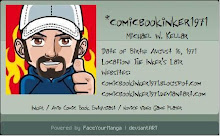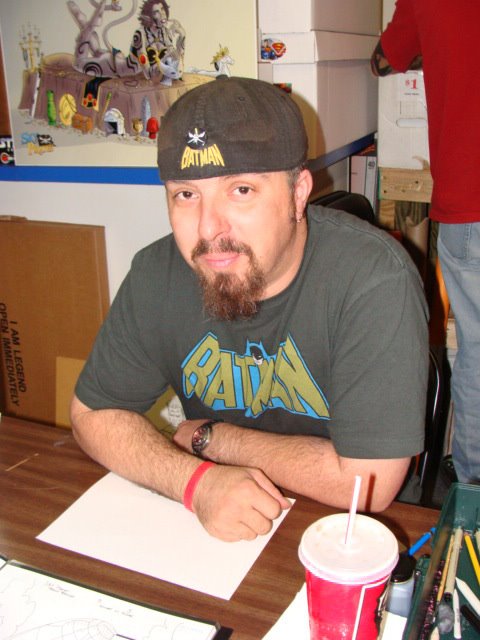 To all my BlogSpot readers,
To all my BlogSpot readers,
I am putting out a call for anyone on BlogSpot to submit artwork to be featured in the 2008 Comics & Toys MonsterCon Convention Magazine...The convention is October 4-5, 2008...all artwork needs to be submitted to me by September 7, 2008 and needs to be Black & White in a 300DPI TIFF format. This magazine will be approximately 24 pages in length (or more if need be) and will be the size of a standard comic book.
Anyone who submits artwork for the convention magazine and will not be attending MonsterCon in October, I will make sure you receive a copy of the 2008 MonsterCon Convention Magazine.
The official title for MonsterCon is : "Comics & Toys MonsterCon - The Supernatural, Sci-Fi, Superhero Show", now with that being said...what I am asking for is for some of my Deviant friends to consider drawing art for this convention magazine.
The art can be a combination of all three genres or each individual genre (whatever your artist ability draws you to do) and you can include the MonsterCon logo if so desired.
Also, anyone who would like to place an Ad in the Comics & Toys MonsterCon Convention Magazine full page rates are $100.00, half page rates are $50.00 and quarter page rates are $25.00...I do accept paypal and can note you the paypal info upon request.
Thank You for taking the time to read this blog entry in regards to MonsterCon 2008.
***You can also see the Comics & Toys MonsterCon 2008 flyer by clicking on this http://comicbookinker1971.deviantart.com/art/New-Deviant-ID-for-MonsterCon-81422953
Aug 28, 2008
The Comics & Toys MonsterCon 2008
Written by: Michael W. Kellar at 8/28/2008 06:33:00 PM 1 comments
Labels: Comic Book Convention
Aug 21, 2008
Tim Townsend


Written by: Michael W. Kellar at 8/21/2008 09:03:00 PM 0 comments
Aug 8, 2008
What is a Comic Book Inker?!
 The inker is one of the two line artists in a traditional comic book, or graphic novel. After the penciler gives a drawing (or copy of the drawing) to the inker, the inker uses black ink, usually India ink, to produce refined black outlines over the rough pencil lines. The ink may be applied with a pen or a brush, and many inkers use both. The inker is usually responsible for every black line on the page, except for letters, which are handled by a letterer. In comic strips, as well as Japanese manga, one artist takes responsibility for penciling, inking and lettering, either doing it all him or herself (as for example Charles M. Schulz) or hiring assistants. For comics printed in color, there is usually a separate colorist.
The inker is one of the two line artists in a traditional comic book, or graphic novel. After the penciler gives a drawing (or copy of the drawing) to the inker, the inker uses black ink, usually India ink, to produce refined black outlines over the rough pencil lines. The ink may be applied with a pen or a brush, and many inkers use both. The inker is usually responsible for every black line on the page, except for letters, which are handled by a letterer. In comic strips, as well as Japanese manga, one artist takes responsibility for penciling, inking and lettering, either doing it all him or herself (as for example Charles M. Schulz) or hiring assistants. For comics printed in color, there is usually a separate colorist.
Although proper inking is critical to giving comic artwork a professional look, it is often seen as more technical than penciling and is less glamorous, as many inkers go unrecognized. This image has been parodied in the Kevin Smith movie Chasing Amy, where Banky Edwards is accused of merely "tracing" the images drawn by the penciler, Holden McNeil. While inking does involve tracing pencil lines in a literal sense, it also requires interpreting the pencils, giving proper weight to the lines, correcting mistakes, and making other creative choices. The look of a penciler's final art can vary enormously depending on the inker.
A pencil drawing can have an infinite number of shades of grey, depending on the hardness of the graphite and the pressure applied by the artist. By contrast, an ink line generally can be only solid black. Accordingly, the inker has to translate pencil shading into patterns of ink, as for example by using closely spaced parallel lines, feathering or cross-hatching.
Some inkers will often do more than simply interpreting the pencil markings into pen and brush strokes; depending on how much detail the penciler puts into the pencil drawings, the inker might add shading or be responsible for the placement of black spaces and shadows in the final drawing, for example. An experienced inker paired with a novice penciler might be responsible for correcting anatomical or other mistakes, modifying facial expressions, or changing or improving the artwork in a variety of other ways. Alternatively, an inker may do the basic layout of the page, give the work to another artist to do more detailed pencil work, and then ink the page himself (as Joe Simon often did when inking Jack Kirby, or as Michael T. Gilbert collaborated with penciller Craig Russell on the Elric of Melniboné series).
The division between penciller and inker described here is most frequently found where the penciler and inker are hired independently of each other by the publisher. Where an artist instead hires his own assistants, the roles are less structured; an artist might, for example, ink all the faces of the characters while leaving the assistant to ink in the backgrounds, or work with the inker in a more collaborative fashion.
Even in traditional North American comic books, many artists regularly ink their own work: Joe Kubert and Jim Aparo would usually pencil, ink and letter, considering the placing of balloons as an integral part of the page, while artists such as Steve Ditko, Kurt Schaffenberger, Nick Cardy, and Bill Everett almost always inked their own work, sometimes inking the work of other pencilers as well.
It is possible to digitally ink using computers, a practice that is becoming more common as inkers learn to use powerful drawing and editing tools, such as Adobe Illustrator and Photoshop, Inkscape, Corel Painter, and Manga Studio. A graphics tablet is the most common tool used to accurately ink digitally, and if it is done in a vector-based program, pixelization due to changes in resolution are no longer an issue. However, the process is considered by many to be more time-consuming.
Inker stamp provided by fellow inker Diana Greenhalgh http://mechangel2002.deviantart.com/art/Inker-Stamp-1-65408895
Here is a piece inked by Diana Greenhalgh (http://mechangel2002.deviantart.com/) it is Re-Animator Issue 1 page 21...look at how Diana has embellished from the penciled page to the inked page.
This image can be found at http://mechangel2002.deviantart.com/art/Re-Animator-issue-1-pg-21-INKS-70757618
Written by: Michael W. Kellar at 8/08/2008 11:37:00 AM 1 comments
Labels: Comic Book Inker, Diana Greenhalgh, Inker






